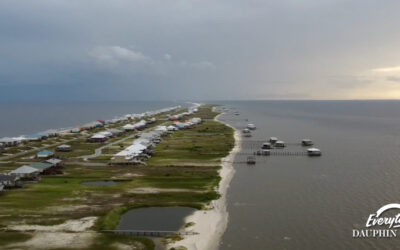For more than three centuries, Dauphin Island has stood as Alabama’s first line of defense against Gulf hurricanes. This 14-mile barrier island has been split in half, completely submerged, rebuilt, and reshaped countless times by tropical cyclones. Yet it endures, its residents returning after each storm with a resilience that defines coastal Alabama culture. This comprehensive chronicle documents every major hurricane to impact Dauphin Island, revealing patterns of destruction and recovery that continue shaping the island today.
Pre-Colonial and Early Historical Storms (1700-1850)
The Great Hurricane of 1711
The first well-documented hurricane to devastate Dauphin Island struck in September 1711, when the island served as the capital of French Louisiana. French colonist Jean-Baptiste Le Moyne de Bienville recorded that the storm surge completely overwashed the island, destroying most structures and forcing the colonial government to relocate to Mobile. Twenty-three colonists died, and the island’s small cemetery was washed into the sea – bones and coffins scattered across the beach, adding another grim chapter to what was then still called “Massacre Island.”
The Hurricane of 1740
Spanish records from Pensacola describe a massive hurricane in September 1740 that altered Dauphin Island’s geography. The storm cut a new pass through the island’s center, temporarily creating two separate islands. This division would heal naturally through sand accretion over the following decades, only to be reopened by future storms – a pattern that would repeat throughout the island’s history.
The Great Mobile Hurricane of 1772
British colonial records document a September 1772 hurricane that drove a 12-foot storm surge across Dauphin Island. The recently constructed British fortifications were severely damaged, and the island’s small permanent population sought refuge in the highest elevations of the maritime forest. This storm established what would become a survival tradition: islanders learning to read the signs and evacuate to specific elevated areas that historically survived overwash.
The Hurricanes of 1812 and 1819
As Alabama transitioned from Spanish to American control, two significant hurricanes struck. The August 1812 storm coincided with the War of 1812, complicating American military preparations in the region. The July 1819 hurricane arrived just as Alabama was achieving statehood, destroying early American attempts to develop the island as a military outpost. Fort Gaines’ construction, begun in 1821, incorporated lessons learned from these storms, with foundations driven deep into the sand.
The Antebellum and Civil War Era (1850-1865)
The Great Storm of 1852
The September 1852 hurricane produced the highest storm surge recorded in the 19th century – an estimated 15 feet above mean high tide. The storm split Dauphin Island into three sections, creating temporary passes that took years to close naturally. The newly established Dauphin Island Lighthouse, completed just months earlier, survived but suffered significant damage. Several fishing families who had settled on the island lost everything, beginning a pattern of rebuilding that would define island culture.
The Confederate Hurricane of 1860
A October 1860 hurricane struck just as Alabama was preparing for potential secession. The storm damaged the incomplete Fort Gaines, delaying its combat readiness. Confederate engineers had to rebuild several bastions and reset gun emplacements, work that was still ongoing when Union forces attacked in 1864. Military correspondence suggests this hurricane influenced Confederate defensive planning, leading to additional earthwork reinforcements designed to absorb storm surge.
The Reconstruction through the Early 20th Century (1865-1940)
The Great Hurricane of 1893
The October 1893 hurricane, known as the “Chenier Caminanda Hurricane,” killed over 2,000 people along the Gulf Coast. On Dauphin Island, the storm surge reached 16 feet, completely overwashing the eastern end. The lighthouse keeper’s log, one of the few surviving documents, describes waves breaking over the lighthouse gallery 50 feet above sea level. Every structure on the island except Fort Gaines and the lighthouse was destroyed or severely damaged.
The Hurricanes of 1906 and 1916
September 1906 brought two hurricanes within two weeks, a one-two punch that left Dauphin Island nearly uninhabitable. The first storm, on September 19, weakened the defensive dunes; the second, on September 27, exploited this vulnerability with a massive surge. An estimated 40% reduction in the island’s width, and Pelican Island, a small satellite island, disappeared entirely.
The July 1916 hurricane arrived from an unusual westerly direction, catching residents off guard. The Mobile Register reported that Dauphin Island was “swept clean as a floor,” with not a single structure left standing on the island’s western end. This storm motivated the first serious discussions about building a bridge to improve evacuation capabilities.
The 1926 Miami Hurricanes’ Impact
Though centered far to the east, the September 1926 “Great Miami Hurricane” generated enormous swells that battered Dauphin Island for three days. The prolonged wave action carved away massive sections of beach, and several Confederate-era fortifications that had survived previous storms finally succumbed. The island’s sole general store, rebuilt after 1916, was undermined and collapsed into the surf.
The Labor Day Hurricane Effects of 1935
While the catastrophic Labor Day Hurricane devastated the Florida Keys, its outer bands brought an 8-foot surge to Dauphin Island. Though minor compared to direct hits, this storm demonstrated the island’s vulnerability to distant systems and influenced building practices – new structures were increasingly built on stilts rather than ground level.
The Modern Era Begins (1940-1979)
The Hurricane of 1947
The September 1947 hurricane marked a turning point in Dauphin Island’s history. This Category 3 storm made direct landfall on the island with sustained winds of 115 mph. The storm surge of 11.2 feet was precisely measured for the first time by U.S. military personnel stationed at Fort Gaines. Every building on the island, except the fort and lighthouse, suffered damage. The island was cut into two sections at its narrow middle, a break that would persist for six months.
Post-storm aerial photography revealed that the island had migrated northward by an average of 150 feet – the first scientific documentation of the island’s gradual movement toward the mainland. This process continues to this day.
Hurricane Flossy (1956)
Hurricane Flossy in September 1956 tested the newly completed Dauphin Island Bridge, which had been completed just a year earlier. While the bridge survived, approaches on both sides were severely damaged. The storm’s 9-foot surge flooded the island’s nascent tourism infrastructure, destroying several fishing camps and the island’s first modern motel. However, the bridge’s survival proved its worth – evacuation and recovery were far more efficient than in previous storms.
Hurricane Ethel (1960)
Though rapidly weakening at landfall, Hurricane Ethel’s September 1960 arrival coincided with abnormally high tides, producing a 10-foot surge that surprised residents expecting a minor storm. The island’s growing vacation home community suffered its first major test, with 40% of structures suffering significant damage. Insurance claims from Ethel led to stricter building codes and the requirement for elevated construction.
Hurricane Camille (1969)
Hurricane Camille, the second-most intense hurricane to strike the United States, passed just east of Dauphin Island in August 1969. While the Mississippi coast bore the catastrophic impact, Dauphin Island experienced sustained winds of 100 mph and a 10-foot surge. The island’s eastern end was overwashed, Fort Gaines flooded for the first time since the Civil War, and 90% of structures suffered damage.
Camille’s aftermath brought federal disaster relief to the island for the first time, establishing precedents for future recovery efforts. The storm also accelerated beach erosion studies, revealing that Dauphin Island had lost 30% of its landmass since 1900.
Hurricane Frederic: The Modern Benchmark (1979)
Hurricane Frederic deserves special attention as the storm that transformed Dauphin Island’s modern history. Making landfall on September 12, 1979, as a Category 3 hurricane, Frederic’s eye passed directly over the island.
The Storm’s Fury
Wind speeds reached 130 mph, with gusts estimated at 145 mph. The storm surge measured 14 feet on the Gulf side, while Mobile Bay was pushed to record levels on the island’s north shore. For six hours, Dauphin Island ceased to exist as a continuous landmass – it became a series of sandy shoals with only the highest dunes remaining above water.
Immediate Devastation
- The Dauphin Island Bridge collapsed, its center span destroyed
- 90% of structures were destroyed or suffered significant damage
- The island was cut into five separate sections
- Dunes were flattened, some areas losing 15 feet of elevation
- The island’s only grocery store, gas station, and restaurant were obliterated
- Fort Gaines suffered its worst damage since the Civil War
Long-term Consequences
Frederic’s impact extended far beyond physical destruction. The bridge collapse isolated the island for three years, accessible only by ferry. Many residents never returned. Property values plummeted. The island’s year-round population dropped from nearly 1,000 to under 400.
However, Frederic also sparked the modern era of hurricane-resistant construction. New building codes required elevated structures, reinforced pilings, and hurricane straps. The rebuilt bridge, completed in 1982, was engineered to withstand Category 5 winds. Federal and state investment in recovery exceeded all previous disasters combined, setting precedents for future storm response.
The Satellite Era: Precise Documentation (1980-2004)
Hurricane Elena (1985)
Hurricane Elena’s erratic path in August-September 1985 kept Dauphin Island under threat for five days. Though the storm never made direct landfall, prolonged battering from tropical storm-force winds and 8-foot seas caused severe beach erosion. Elena marked the beginning of modern evacuation procedures, with satellite imagery allowing precise tracking that gave residents adequate warning time.
Hurricane Georges (1998)
Hurricane Georges in September 1998 provided the first test of post-Frederic building standards. The Category 2 storm brought a 10-foot surge and sustained winds of 90 mph. While older structures suffered severe damage, post-Frederic buildings generally survived intact, validating the new building codes. Georges cut a new pass through the island’s western end – “Georges Cut” – which remained open until artificially filled in 2001.
The storm revealed archaeological treasures, exposing 18th-century French colonial artifacts and Native American pottery, leading to critical historical discoveries documented by the Dauphin Island Sea Lab.
Hurricane Ivan (2004)
Hurricane Ivan in September 2004 demonstrated the vulnerability of even hurricane-resistant construction to extreme events. The Category 3 hurricane’s 12-foot surge and 115 mph winds destroyed or severely damaged 60% of the island’s structures. The western end lost 50 feet of shoreline in six hours. Sand from Dauphin Island was found as far inland as Mobile – 35 miles away.
Ivan’s impact included:
- Destruction of the public pier
- Severe damage to the new bridge (though it remained standing)
- Loss of 40% of the island’s structures
- Creation of multiple breaches requiring artificial filling
- $100 million in property damage
The Age of Katrina and Climate Change (2005-Present)
Hurricane Katrina (2005)
Less than a year after Ivan, Hurricane Katrina delivered another devastating blow on August 29, 2005. Though Katrina is remembered primarily for New Orleans’ flooding, Dauphin Island experienced:
- 15-foot storm surge
- Complete overwash of the western end
- Loss of 150 homes
- Reduction of island width by 30% in some areas
- Sand elevation loss averaging 4 feet island-wide
The back-to-back impacts of Ivan and Katrina sparked serious discussions about the island’s long-term viability. Some scientists and officials suggested allowing the island to revert to an uninhabited state. Residents fought back, arguing their community’s cultural importance and the island’s role in protecting Mobile Bay.
The Recovery Years (2006-2010)
The period following Katrina saw unprecedented beach restoration efforts. The U.S. Army Corps of Engineers spent over $30 million on sand replenishment, dune restoration, and breach filling. However, these efforts were repeatedly challenged by smaller storms:
- Tropical Storm Arlene (2005) – Minor erosion
- Hurricane Dennis (2005) – 6-foot surge
- Tropical Storm Ida (2009) – Moderate beach erosion
Hurricane Isaac (2012)
Hurricane Isaac’s slow movement in August 2012 produced prolonged surge conditions, causing more erosion than stronger but faster-moving storms. The western end of the island was overwashed for 36 hours, and several restored dunes were eroded entirely. Isaac demonstrated that storm duration could be as destructive as intensity.
Hurricane Nate (2017)
Hurricane Nate in October 2017 struck as a Category 1 hurricane but produced surge impacts similar to those of stronger storms due to its large size and coincidence with high tides. Nate reopened Katrina Cut, which had been artificially filled, proving the temporary nature of human interventions against natural processes.
Hurricane Sally (2020)
Hurricane Sally in September 2020 brought a new challenge – extreme rainfall. While the storm surge was moderate (6-8 feet), Sally dumped over 20 inches of rain on the island in 24 hours. This freshwater flooding was unprecedented, damaging structures that had survived surge events. Sally’s slow movement (3 mph) meant the island endured tropical storm conditions for nearly 48 hours.
Hurricane Zeta (2020)
Just six weeks after Sally, Hurricane Zeta struck in October 2020. Though only a Category 2 at landfall, Zeta’s fast forward speed (20+ mph) added to its wind impact. The storm demonstrated the compound effects of multiple storms in one season – areas weakened by Sally failed under Zeta’s assault.
Recent Storms and Current Vulnerabilities
The 2020s have already shown increased storm frequency:
- Tropical Storm Claudette (2021) – 4-foot surge
- Hurricane Ida (2021) – Moderate surge despite Louisiana landfall
- Tropical Storm Alberto (2024) – Early-season surprise
Current vulnerabilities include:
- Western end elevation is now below mean high tide in places
- Katrina Cut repeatedly reopened despite filling attempts
- Accelerated erosion rates (50 feet/year in some areas)
- Reduced sand supply from upstream development
- Sea level rise ais dding to surge heights
Patterns and Lessons Learned
Storm Frequency Analysis
Historical records reveal:
- Major hurricanes (Category 3+) impact the island every 10-15 years on average
- Storm frequency has increased 40% since 1990
- September is the most dangerous month (60% of major storms)
- Back-to-back storm years occur roughly every 20 years
Evolution of Survival Strategies
Over three centuries, Dauphin Island residents have developed unique adaptation strategies:
18th-19th Century: Temporary evacuation to the mainland, rebuilding with salvaged materials
Early 20th Century: Construction of storm shelters, community mutual aid systems
Post-1950: Elevated construction, improved evacuation routes via bridge
Post-Frederic (1979): Hurricane-resistant building codes, federal flood insurance
Post-Katrina (2005): Managed retreat from the western end, living shoreline projects
Current Era: Resilient design, nature-based solutions, acceptance of island migration
The Ongoing Debate
Modern Dauphin Island faces existential questions after each storm:
- Should development be restricted to the eastern, more stable end?
- Is beach replenishment economically justified?
- Can nature-based solutions provide adequate protection?
- Should the island transition to seasonal/recreational use only?
- How much public funding should support private property protection?
The Future: Projections and Preparations
Climate scientists project concerning trends for Dauphin Island:
- Sea level rise of 1-3 feet by 2050
- Increased hurricane intensity (not necessarily frequency)
- More rapid intensification events
- Expanded hurricane season (May-November)
- Increased rainfall totals from storms
Current adaptation efforts include:
- Living shoreline projects using oyster reefs
- Strategic retreat from vulnerable areas
- Enhanced building codes requiring FEMA 500-year flood elevation
- Improved evacuation planning and emergency communication
- Beach and dune restoration with hurricane-resistant vegetation
Dauphin Island’s Resilience
Dauphin Island’s hurricane history is more than a chronicle of destruction – it’s a testament to human resilience and adaptation. For over 300 years, storms have shaped not just the island’s geography but its culture, creating a community that understands both the beauty and brutality of barrier island life.
Each hurricane has taught lessons incorporated into the island’s collective memory. From French colonists learning to read storm signs to modern residents building resilient homes, survival knowledge passes through generations. The island itself demonstrates resilience, reforming and rebuilding through natural processes even as human intervention attempts to maintain artificial stability.
As climate change presents new challenges, Dauphin Island stands as a living laboratory for coastal adaptation. Its hurricane history provides crucial data for understanding long-term barrier island dynamics and human responses to repeated natural disasters. Whether the island continues as a year-round community or transitions to a different role, its hurricane legacy will remain central to understanding Gulf Coast resilience.
The story of Dauphin Island’s hurricanes is ultimately about choice – the choice to rebuild after each storm, to adapt rather than abandon, to find beauty worth protecting despite nature’s periodic fury. As long as people choose to call Dauphin Island home, this hurricane history will continue being written, one storm at a time.
ADDITIONAL RESOURCES
- NOAA Historical Hurricane Database (HURDAT) – https://www.aoml.noaa.gov/hrd/hurdat/Data_Storm.html
- U.S. Geological Survey Coastal Change Hazards Portal – https://marine.usgs.gov/coastalchangehazardsportal/
- National Hurricane Center Storm Archive – https://www.nhc.noaa.gov/data/
- Dauphin Island Sea Lab Coastal Research – https://www.disl.edu/research/coastal-research/
- NOAA Sea Level Rise Viewer – https://coast.noaa.gov/slr/



